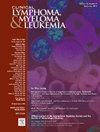Comparison of Real-World Outcomes in Patients With Follicular Lymphoma Treated With BR Versus RCHOP-Like Regimens
IF 2.7
4区 医学
Q2 HEMATOLOGY
引用次数: 0
Abstract
Background
Patients with follicular lymphoma (FL) grade (G) 1-3A who meet treatment criteria are commonly treated with chemo-immunotherapy regimens such as bendamustine plus rituximab (BR) or rituximab plus cyclophosphamide, doxorubicin, vincristine, prednisone (RCHOP). Two prospective trials have compared BR to RCHOP-like regimens and showed improved progression free survival with BR in FL G1-2 patients. However, in real-world practice, there is clinical variability in utilization of BR versus RCHOP-like regimens. Additionally, the optimal treatment for patients with FL G3A remains unclear.
Methods
We used a nationwide electronic health record-derived de-identified database to compare outcomes in 2089 patients with FL G1-3A treated with frontline BR versus RCHOP-like regimens.
Results
We demonstrated clinical improvement in time to next treatment or death (TTNTD) with BR (median 96 vs. 78 months, HR 1.15, 95% CI 0.986-1.332, P = .086), albeit not statistically significant. No difference in overall survival (OS) was observed. Maintenance rituximab was associated with improved TTNTD and OS. Among G3A patients (N = 304), TTNTD was comparable between the 2 regimens, however OS was significantly improved with RCHOP-like regimens in univariate analysis (median 138 vs. 96 months, HR 0.51, 95% CI 0.313-0.834, P = .007).
Conclusions
In conclusion, this study of real-world patients supports the use of BR and rituximab maintenance for front-line treatment of FL. Further prospective studies are needed to determine the ideal treatment for FL G3A.
BR与rchop样方案治疗滤泡性淋巴瘤患者实际预后的比较
背景:符合治疗标准的滤泡性淋巴瘤(FL)级(G) 1-3A患者通常采用化学免疫治疗方案,如苯达莫司汀+利妥昔单抗(BR)或利妥昔单抗+环磷酰胺、阿霉素、长春新碱、强的松(RCHOP)。两项前瞻性试验将BR与rchop样方案进行了比较,结果显示FL G1-2患者BR可改善无进展生存期。然而,在现实世界的实践中,BR与rchop样方案的应用存在临床差异。此外,FL G3A患者的最佳治疗方法尚不清楚。方法:我们使用一个全国性的电子健康记录衍生的去识别数据库来比较2089例FL G1-3A患者接受一线BR和rchop样方案治疗的结果。结果:我们证实了BR在下一次治疗或死亡时间(TTNTD)方面的临床改善(中位96个月vs. 78个月,HR 1.15, 95% CI 0.986-1.332, P = 0.086),尽管没有统计学意义。总生存期(OS)无差异。维持性利妥昔单抗与TTNTD和OS改善相关。在G3A患者(N = 304)中,两种方案之间的TTNTD具有可比性,但在单因素分析中,rchop样方案显著改善了OS(中位138个月vs. 96个月,HR 0.51, 95% CI 0.313-0.834, P = 0.007)。结论:总之,本研究对现实世界患者的研究支持使用BR和利妥昔单抗维持治疗FL的一线治疗,需要进一步的前瞻性研究来确定FL G3A的理想治疗方法。
本文章由计算机程序翻译,如有差异,请以英文原文为准。
求助全文
约1分钟内获得全文
求助全文
来源期刊

Clinical Lymphoma, Myeloma & Leukemia
ONCOLOGY-HEMATOLOGY
CiteScore
2.70
自引率
3.70%
发文量
1606
审稿时长
26 days
期刊介绍:
Clinical Lymphoma, Myeloma & Leukemia is a peer-reviewed monthly journal that publishes original articles describing various aspects of clinical and translational research of lymphoma, myeloma and leukemia. Clinical Lymphoma, Myeloma & Leukemia is devoted to articles on detection, diagnosis, prevention, and treatment of lymphoma, myeloma, leukemia and related disorders including macroglobulinemia, amyloidosis, and plasma-cell dyscrasias. The main emphasis is on recent scientific developments in all areas related to lymphoma, myeloma and leukemia. Specific areas of interest include clinical research and mechanistic approaches; drug sensitivity and resistance; gene and antisense therapy; pathology, markers, and prognostic indicators; chemoprevention strategies; multimodality therapy; and integration of various approaches.
 求助内容:
求助内容: 应助结果提醒方式:
应助结果提醒方式:


